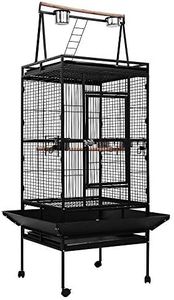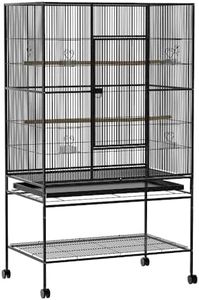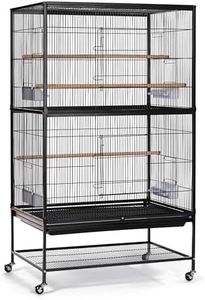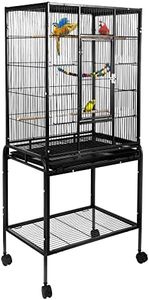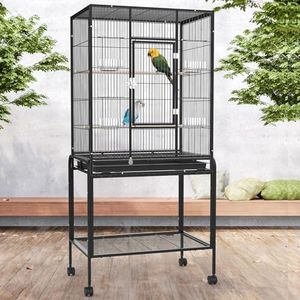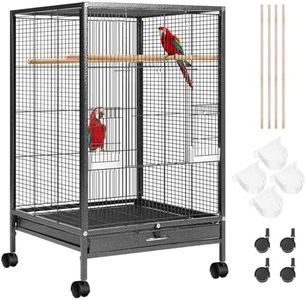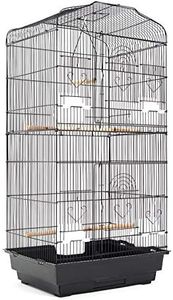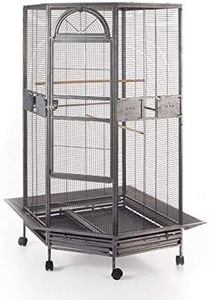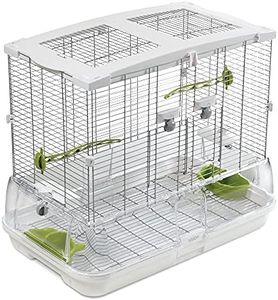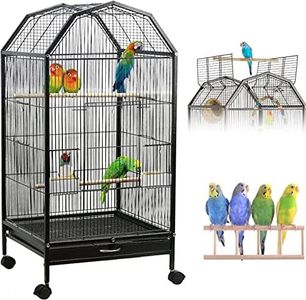We Use CookiesWe use cookies to enhance the security, performance,
functionality and for analytical and promotional activities. By continuing to browse this site you
are agreeing to our privacy policy
10 Best Cages For Cockatiels
From leading brands and best sellers available on the web.By clicking on a link to a third party's website, log data is shared with that third party.
Buying Guide for the Best Cages For Cockatiels
Choosing the right cage for your cockatiel is crucial for their health, safety, and happiness. Cockatiels are active and playful birds that require a comfortable, secure, and stimulating environment. The ideal cage should give them plenty of room to move, climb, and spread their wings, as well as being easy for you to clean and maintain. When deciding on a cage, it's important to consider your bird's daily habits and how much time they will spend inside, as well as where the cage will be placed in your home.Cage SizeCage size refers to the overall dimensions of the cage—its height, width, and depth. This is crucial because cockatiels need enough room to fly short distances, stretch their wings, and climb around without bumping into bars or accessories. Cages are typically described as small, medium, or large. Small cages might be suitable for temporary use or travel, but for a single cockatiel, a medium cage generally provides enough space for comfort, while a large cage is ideal, offering better movement and enrichment possibilities. Always make sure the cage allows your cockatiel to fully extend their wings and includes additional space for perches, toys, and food bowls. If you have more than one cockatiel, always size up to avoid crowding. Think about how active your bird is—if they spend a lot of time in their cage, bigger is better.
Bar SpacingBar spacing is the distance between the bars of the cage. This is important because spaces that are too wide can be unsafe—your cockatiel might squeeze through or get stuck, while spaces that are too narrow can block the bird’s view or climbing ability. For cockatiels, the ideal bar spacing is usually between ½ inch and ⅝ inch. Narrower bars might suit very young or smaller cockatiels, while wider bars can pose a hazard. Always match the bar spacing to your bird’s size and be cautious if you have other pets or young birds, as safety comes first.
Bar Orientation and StrengthBar orientation refers to whether the bars are placed vertically, horizontally, or a mix of both. Cockatiels enjoy climbing, and horizontal bars on at least two sides of the cage make it much easier for them to clamber about and exercise their feet. The strength or thickness of the bars matters too—bars should be strong enough to resist bending or breaking if your bird chews or pulls on them. If your cockatiel is particularly active or curious, opt for a cage with sturdy, chew-resistant bars to prevent escapes and accidents.
Door Design and AccessDoor design includes the size, type, and placement of the cage doors. This affects how easy it is to reach in for cleaning, feeding, or interacting with your pet. Larger doors make it simpler to add toys or perches and to lift your cockatiel in or out, while smaller doors can sometimes be safer for keeping the bird inside. Some cages also include multiple doors or feeding ports. Think about how often you plan to interact with your bird and how easy you want cleaning and maintenance to be—choose a cage that offers convenient, secure access points.
Material and FinishThe material and finish of the cage refer to what the cage is made of—typically powder-coated metal, stainless steel, or sometimes painted wire. The right material is important for durability and your cockatiel’s health. Stainless steel is rust-resistant and non-toxic, ideal for birds that chew on bars, while powder-coated cages are generally safe but should be checked for chips or peeling, as birds can ingest flakes. Painted cages are less common and require more caution to ensure the paint is bird-safe. Always choose a cage made from non-toxic materials and check that all finishes are smooth and safe for contact.
Ease of CleaningEase of cleaning considers how simple it is to maintain a hygienic environment inside the cage. This is important because cockatiels are sensitive to dirty or damp conditions. Look for features like slide-out trays or removable grates that allow you to clean food droppings and waste without disturbing your bird. Removable perches, accessible doors, and smooth surfaces can also make routine cleaning easier. If you have limited time for maintenance, prioritize a cage design that streamlines cleaning tasks.
Perches and AccessoriesPerches and accessories include anything extra inside the cage that enhances the cockatiel’s environment—such as perches, ladders, swings, and feeding cups. A variety of perch sizes and textures helps keep your bird’s feet healthy and provides mental stimulation. Some cages come with basic starter accessories, but you may want to upgrade or add more. Consider your bird’s activity level and preferences; opt for a cage that has space and mounting points for the accessories your cockatiel enjoys.
Shape and PlacementThe shape of the cage (square, rectangular, round, or dome-topped) can affect your cockatiel’s comfort and well-being. Generally, rectangular cages are considered best because they provide good flight space and clear corners, which help birds feel safe. Cage placement within your home matters too—pick a shape and size that fits comfortably in your space, avoids cold drafts or direct sun, and allows your cockatiel to be part of family life without feeling stressed. Consider where you’ll put the cage and how its shape will work in that room.
